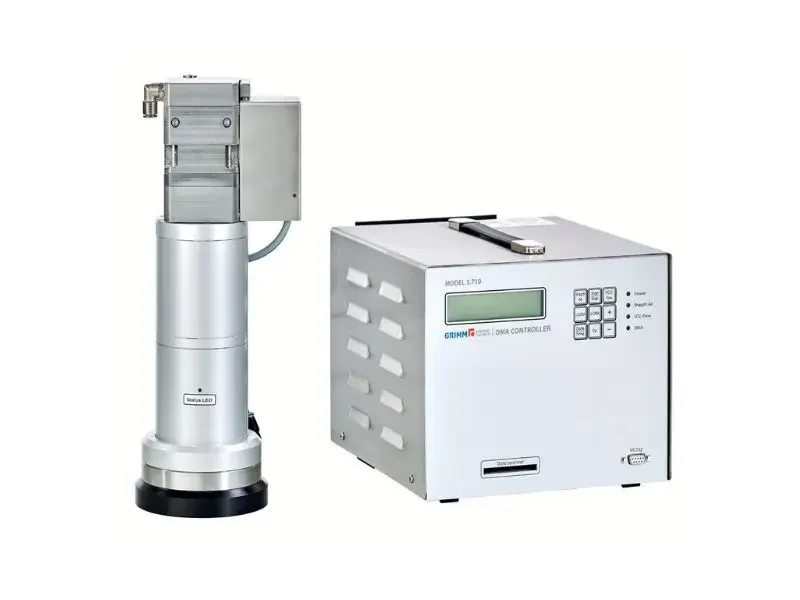How it works
The GRIMM Aerosol Technik Scanning Mobility Particle Sizer System is a particle sizer system that features the Vienna-type DMA design, well-known for highest size resolution and lowest particle diffusional losses – even for the smallest particles. A CPC uses the same laser scatter method of detection as many of our other dust monitors. A CPC is however able to measure much smaller nanoparticles than a normal laser-based dust monitor due to the condensation chamber. In the condensation chamber, dust particles are exposed to a supersaturated solution of n-Butanol. The butanol condenses on the surface of the dust particles, causing them to grow to a sufficient size for laser scatter detection.
An SMPS+C (Scanning Mobility Particle Sizer + Condensation particle counter), is a CPC with a device called a DMA column on the front. The DMA column uses a variable electric field to only allow particles of a certain size range to pass through for measurement at the CPC. By scanning the DMA column over a range of electric potentials, a particle size spectrum can be produced. Without a DMA column, a standalone CPC will count all particles in the air without discerning any size information..
The SMPS+E systems include the GRIMM 5706 DMA controller and the GRIMM 5705 fast and low noise FCE and can be operated at aerosol inlet flow rates of 1 – 5 L/min and sheath flow rates of 3 – 20 L/min. GRIMM offers a flexible design of the Vienna-type DMA with three electrodes of different length to accommodate a variety of experimental needs.
GRIMM’s unique FCE design applies a rinsing air flow around the insulator of the Faraday Cup to minimise effects of leakage currents due to internal particle contaminations. The instrument is optimised to reduce the effects of mechanical shocks and pressure differences, enabling the SMPS+E as a reference instrument for the calibration of nanoparticle counters.
These systems comprise a DMA for the classification of particles, a Condensation Particle Counter (CPC) as detection system, and a software package. According to the intended application DMAs can be used either with a SMPS+C compatible stationary CPC or with the mobile CPC model 5.403. Specifications of the CPC are listed on separate data sheets. All SMPS+C compatible CPCs, however, serve not only for particle detection. They also supply air flows through the DMA, control the high voltage supply, and form the interface to the PC with the SMPS+C software. The mobile system can be used without an attached computer. Before measurements, all SMPS+C systems carry out a self test to guarantee highly reliable results. The self test comprises a leak test, a check of the connected DMA type, a test for leak currents in the DMA, and monitoring of a proper condensation process.
Applications
- Fundamental aerosol research
- Environmental & climate studies
- Nanotechnology process monitoring
- Printer emission studies
- Inhalation & exposure studies
- Studies on atmospheric nucleation
- Studies on nanoparticle growth
- Coagulation & transport
- Engine exhaust studies
- Mobile aerosol studies
- Workplace monitoring
Servicing
Data sheets and specifications are subject to change, and Enviro Technology cannot be held responsible for inaccuracies in manufacturer-issued data sheets. To confirm specifications and obtain the latest issue of the data sheet, please contact us.
Datasheet
Scanning Mobility Particle Sizer Systems (SMPS+C & SMPS+E)
Specifications
- GRIMM SMPS+C Systems
- Size Range 5.4 – 358 nm (M-DMA), 11 – 1110 nm (L-DMA) Concentration Range: See data sheet of connected CPC
- Size Resolution 44 channels, as standard. Optionally up to 255 channels. Logarithmic spacing.
- Air Flow System
- Flow Rates of Sample Air 0.3 L/min
- Flow Rate of Sheath Air 3.0 L/min
- Flow Control: Through differential pressure sensors across a heated orifice. Insensitive against variations in ambient temperature and pressure
- Aerosol Carrier Gas: Air and inert gases
- Liquid System Working Fluid 1-Butanol (Reagent-grade p.A.) for activation of hydrophobic and hydrophilic particles
- Condensate Removal: Continuous drain with a micro-pump into drain bottle Communications RS-232 9-pin D connector, ASCII based command set Memory Card 1) PCMCIA SRAM 4MB Analog Inputs Port for 3 optional analog climatic or gas sensors






